Indonesia is an archipelago (a group of islands) stretching along the equator between the Southeast Asian mainland and Papua New Guinea, with which it shares an island. The country has a total land area of 1,919,440 square kilometers (741,096 square miles), or about 3 times the size of Texas. An additional 3.2 million square kilometers (1,235,520 square miles) of ocean is within Indonesia's borders.
Being a tropical country, Indonesia is blessed with two seasons, namely dry and rainy. Dry usually occurs from June to September and the rest is rainy season. Sunshine is abundant except in rainy season when the sky tends to be cloudy. It is advisable to visit Indonesia during dry season.
Bahasa Indonesia is the national and official language in the entire country. It is the language of official communication, taught in schools and spoken on television. Most Indonesians today speak at least two languages or more, Bahasa Indonesia and their local language, of which Indonesia counts more than 300 regional languages.
The 2000 official census found 203,456,005 Indonesians (though most outside sources estimate 210 million), making Indonesia the world's fourth most populous country. An estimated birth rate of 22.6 per 1,000 people and death rate of 6.31 per 1,000 people means that the population is growing at an annual rate of 1.63 percent. The United Nations Development Program predicts that the population will reach 250.4 million by 2015. Like many developing countries, Indonesia has a young population, with 30.6 percent of its people under the age of 15. In 1998 almost two-fifths of the population lived in urban areas, double the 1975 level.
While religious freedom is stipulated in the Indonesian constitution, the government officially recognizes only six religions: Islam,Protestantism, Roman Catholicism, Hinduism, Buddhism, and Confucianism. Indonesia is the world's most populous Muslim-majority nation, at 87.2% in 2010, with the majority being Sunni (99%). The Shias and Ahmadis respectively constitute 0.5% and 0.2% of the Muslim population.
Typical meal:
A typical Indonesian meal consists of steamed rice and one or two main dishes made of fish, meat, chicken or vegetables, sometimes including soup, all of which are served together. A common side dish is sambal.
Manner of eating:
Food is eaten with the fingers or with a spoon and fork. When eating with the fingers, Indonesians use their right hand only. The left hand is used for less hygienic matters. They always leave some food on the plate or drink in the glass to indicate that they have had enough.
Hawker food:
For a quick bite, there are street vendors peddling their food on their 3-wheeled carts. These stalls are known as kaki lima. Many of these vendors have their own distinctive calls (a beat on a piece of wood, a yell or a bell) to announce their wares ranging from drinks, sweets, rice and noodle meals. Each kaki lima vendor sells only one dish and many sell mee bakso.
Desserts: Desserts often consist of tropical fruits such as starfruit, mangga (mango), manggis (mangosteen), rambutan, durian and nangka (jackfruit). Indonesian desserts are often made from glutinous rice flour, palm sugar and coconut milk. Some favourites are kueh lapis, bubur hitam and es campur.
Desserts:
Desserts often consist of tropical fruits such as starfruit, mangga (mango), manggis (mangosteen), rambutan, durian and nangka (jackfruit). Indonesian desserts are often made from glutinous rice flour, palm sugar and coconut milk. Some favourites are kueh lapis, bubur hitam and es campur.
1- Nasi Goreng:
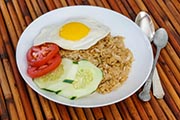
Literally means fried rice, it is actually the usual famous Southeast Asian style of stir-frying cooked rice, but with its very own Indonesian spices and mix.
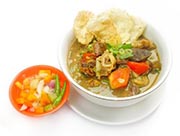 2- Soto Betawi :
2- Soto Betawi :
There are a few Soto here in Indonesia that you must try, first is the Soto Betawi, which the soup is made of beef or beef offal with cow milk, it is a unique variation in itself with a distinct taste.
3- Rendang:
Literally means dry curry, rendang is a really popular dish in Indonesia that is actually
a dry beef stew. It is originated from Minangkabau
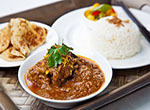 (or also known as Padang) in West Sumatra. That is why it is either called Rendang Padang or Rendang Minangkabau. Rendang is basically meat, normally beef but sometimes liver, chicken, goat or other meats, would be cooked in coconut milk and spices until dry resulting in an intense concoction of taste and texture. It is one of the best food in the world, try it to believe it!
(or also known as Padang) in West Sumatra. That is why it is either called Rendang Padang or Rendang Minangkabau. Rendang is basically meat, normally beef but sometimes liver, chicken, goat or other meats, would be cooked in coconut milk and spices until dry resulting in an intense concoction of taste and texture. It is one of the best food in the world, try it to believe it!
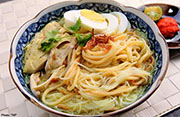 4- Soto Mie / Soto Mee:
4- Soto Mie / Soto Mee:
Sotomie (or Mee Soto) which is one of the most popular soto for its own right, it is either made of chicken or beef for soup and served with noodles and sliced risoles spring rolls.
Of of the best Sotomie in Jakarta can be found at a stall inside Mangga Dua.
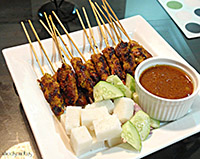 5- Sate ayam – Sate:
5- Sate ayam – Sate:
(satay in other parts of Southeast Asia) Ayam (chicken), is skewered and grilled (BBQ) chicken served with flavourful peanut sauce. It is also known as national dish of Java, Indonesia, making it a strong contender to our Nasi Goreng.
 6- Rawon:
6- Rawon:
Rawon is a black beef soup, made with beef and keluak (black nuts) as the main spice giving it a strong nutty taste and dark in colour, along with other spices and normally served with rice.
7- Gudeg :
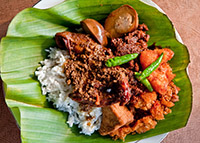 A traditional food hail from Yogayakarta in Central Java, gudeg is a stew made from young jack fruit (nangka) with palm sugar, coconut milk, meat, garlic, and lots of spices. It is one of the most flavourful food in the world, melding everything from taste to textures.
A traditional food hail from Yogayakarta in Central Java, gudeg is a stew made from young jack fruit (nangka) with palm sugar, coconut milk, meat, garlic, and lots of spices. It is one of the most flavourful food in the world, melding everything from taste to textures.
 8- Bakso:
8- Bakso:
Bakso or Baso in Indonesia, is a meatball made from beef surimi (meat paste, normally beef, with some tapioca flour). It is usually serve in a bowl of beef broth with noodles, bihun (rice vermicelli), vegetables, tofu and eggs.
9-Nasi Kuning:
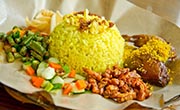 Nasi Kuning (yellow rice) or sometimes known as Nasi Kunyit (turmeric rice) is a famous Indonesian breakfast rice cooked in coconut milk and turmeric. It is usuall serve with some omelette, grated coconut and spices and fried anchovy and kacang (peanuts).
Nasi Kuning (yellow rice) or sometimes known as Nasi Kunyit (turmeric rice) is a famous Indonesian breakfast rice cooked in coconut milk and turmeric. It is usuall serve with some omelette, grated coconut and spices and fried anchovy and kacang (peanuts).
10- Gado gado:
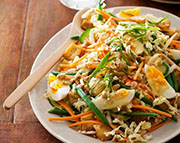 Gado-gado (or also known as Lotek) is an Indonesian salad, a combination of boiled vegetables doused generously with peanut sauce dressing. There are other similar dishes like pecel and atah or karedok.
Gado-gado (or also known as Lotek) is an Indonesian salad, a combination of boiled vegetables doused generously with peanut sauce dressing. There are other similar dishes like pecel and atah or karedok.

is an Ubud Kingdom Palace with beautiful Balinese traditional houses as a residence of Ubud King. It is set in the center of Ubud Bali with traditional art market just in front of it and it is found by Ida Tjokorda Putu Kandel who has commanded from year 1800 - 1823. This palace is an artistic cultural life center, while the traditional market is the symbol of local economics resident. The existence of Puri Saren as a palace is equipped by a Wantilan/auditorium that is a large building of meeting room and a banyan tree as shelter place at the daytime. The traditional market is the place of society economics and its existence is always border on palace as artistic cultural life center. It means that the both pole meeting is describing the dynamics of society and kingdom life.
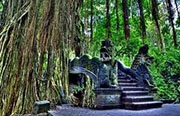
Ubud Monkey Forest is a small rain forest dwelt by some group of monkeys and other tropical animals. It is strategically located in the hearth of Ubud Village, precisely located in the region of Padang Tegal Village, Ubud Sub district and Gianyar Regency. Monkey Forests in Balinese language called Wanara Wana are spread out in the island and Ubud Monkey Forest itself own very important function of the continuity the monkey habitat in Bali. Meanwhile the local community own important role to keep this forest naturally in order to all wild animals able to live smoothly.
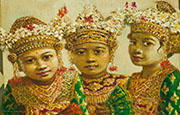 is modern museum collecting the ancient Painting consecution and modern from the famous artist. Ubud is a place where the world's painter found their inspiration to create a painting. You will see some of the world masterpiece from the famous artists in this museum that completes your tour with wonderful experience. The museum is design with Balinese architecture with the natural nature ambience surround it. You will see the amazing art on canvas created by the world class painter and masterpiece just at the Painting Museum. There are several painting museums available in Ubud which you will visit one of them.
is modern museum collecting the ancient Painting consecution and modern from the famous artist. Ubud is a place where the world's painter found their inspiration to create a painting. You will see some of the world masterpiece from the famous artists in this museum that completes your tour with wonderful experience. The museum is design with Balinese architecture with the natural nature ambience surround it. You will see the amazing art on canvas created by the world class painter and masterpiece just at the Painting Museum. There are several painting museums available in Ubud which you will visit one of them.
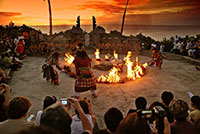
I'll be honest, you are going to find mixed reviews from travelers about visiting the Uluwatu Temple on the southern tip of Bali. People are going to complain about the thieving monkeys (for good reason), the lack of luster offered by the temple, the crowds, the trash, the entrance fee, and the fact that the temple is somewhat isolated from the other many attractions on the island. However, I am going to make a hard stance that the Uluwatu Temple is worth the visit and that's why I'm considering it as one of the highlights of our trip to Bali!